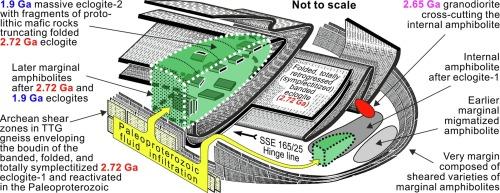Early Precambrian eclogites in the Belomorian Province, eastern Fennoscandian Shield
IF 3.2
2区 地球科学
Q2 GEOSCIENCES, MULTIDISCIPLINARY
引用次数: 0
Abstract
This study focuses on a boudin of Archean amphibolite that occurs in the Gridino eclogite-bearing mélange (Belomorian Province, eastern Fennoscandian Shield) and contains two varieties of eclogite. Eclogite-1 is banded, retrogressed (omphacite is totally replaced by clinopyroxene-plagioclase symplectite), and deformed by recumbent tight folds identical to those in the TTG-amphibolite host. Zircon groups are dated at 2721 ± 26 Ma (Zrn-I, fir-tree zoning, no or small negative Eu anomalies, flat HREE patterns, 700–730 °C, 14–15 kbar), ca. 2.70 Ga (Zrn-II, rims around Zrn-I, grains, 750–900 °C, 11–14 kbar, high-P granulite facies), and ca. 2.70 Ga (Zrn-III, rims around Zrn-II). Newly formed Paleoproterozoic zircon crystals are lacking. Retrogressed eclogite-1 in which amphibolization and epidotization totally obliterated garnet and plagioclase-clinopyroxene symplectites is intruded by 2646 ± 46 Ma old granodiorite. Eclogite-2 is massive, contains preserved omphacite-garnet-quartz-rutile assemblages, and comprises two patches whose boundaries truncate folds in eclogite-1. A Paleoproterozoic age of eclogite-2 is evidenced by previously published 1.90 Ga ages of zircon rims around Archean zircon and newly formed crystals with omphacite inclusions. The largest patch contains tabular enclaves of three varieties of amphibolites. One variety is identical to some bands of totally retrogressed eclogite-1 changed into monomineral amphibolites in both the Neoarchean and Paleoproterozoic. The orientation and attitude of these tabular enclaves are coherent with those of the banding on limbs of recumbent tight folds in eclogite-1 within the boudin and later drag folds at its margins and form one and the same structural carcass or skeleton. These data along with recent findings of inherited 2.68 Ga old zircon with inclusions of omphacite in eclogite-2 indicate that this eclogite developed after Neoarchean eclogite-1 due to fluid infiltration along reactivated Neoarchean shear zones enveloping the boudin. These results favor the idea that the transition to the modern-style plate tectonics started not later than in the Neoarchean.

东芬诺斯坎地盾贝洛莫利亚省的早前寒武纪蚀变岩
这项研究的重点是出现在 Gridino 含夕阳辉石混合岩层(位于东芬诺斯堪地盾的贝洛莫利亚省)中的一块 Archean 闪长岩包岩,其中包含两种夕阳辉石。埃克洛辉石-1 呈条带状,后退(埃克洛辉石完全被黝帘石-斜长石共闪长岩所取代),并因与 TTG-闪长岩主岩相同的后退紧褶皱而变形。锆石组的年代分别为 2721 ± 26 Ma(Zrn-I,枞树带,无或有少量负 Eu 异常,平直的 HREE 模式,700-730 °C,14-15 kbar)、约 2.70 Ga(Zrn-II,Zrn-I 周围的边缘,晶粒,750-900 °C,11-14 kbar,高 P 花岗岩面)和约 2.70 Ga(Zrn-III,Zrn-II 周围的边缘)。缺乏新形成的古新生代锆石晶体。后退斜长岩-1中的闪长岩化和表长岩化完全湮没了石榴石和斜长石-辉石共辉石,被2646±46Ma的花岗闪长岩侵入。斜长岩-2呈块状,含有保留下来的蛇绿岩-石榴石-石英-金刚石组合,由两块斑块组成,其边界截断了斜长岩-1的褶皱。之前公布的 Archean 锆石周围锆石边缘的 1.90 Ga 年龄以及新形成的含有闪长岩包裹体的晶体证明了 eclogite-2 的古新生代年龄。最大的一块包含三种闪长岩的片状飞地。其中一种与新元古代和古新生代的一些完全后退的闪长岩-1转变为单矿物闪长岩的带状岩石相同。这些片状飞地的方位和姿态与鄂绿泥石-1中包丁内的后退紧褶皱肢上的带状以及其边缘后来的拖曳褶皱的方位和姿态一致,构成了同一个结构躯干或骨架。这些数据以及最近在夕照岩-2中发现的含有闪长岩包裹体的2.68Ga古老锆石,都表明这种夕照岩是在新元古代夕照岩-1之后,由于流体沿重新激活的新元古代剪切带渗入包谷岩而形成的。这些结果支持这样一种观点,即向现代板块构造的过渡不会晚于新元古代。
本文章由计算机程序翻译,如有差异,请以英文原文为准。
求助全文
约1分钟内获得全文
求助全文
来源期刊

Precambrian Research
地学-地球科学综合
CiteScore
7.20
自引率
28.90%
发文量
325
审稿时长
12 months
期刊介绍:
Precambrian Research publishes studies on all aspects of the early stages of the composition, structure and evolution of the Earth and its planetary neighbours. With a focus on process-oriented and comparative studies, it covers, but is not restricted to, subjects such as:
(1) Chemical, biological, biochemical and cosmochemical evolution; the origin of life; the evolution of the oceans and atmosphere; the early fossil record; palaeobiology;
(2) Geochronology and isotope and elemental geochemistry;
(3) Precambrian mineral deposits;
(4) Geophysical aspects of the early Earth and Precambrian terrains;
(5) Nature, formation and evolution of the Precambrian lithosphere and mantle including magmatic, depositional, metamorphic and tectonic processes.
In addition, the editors particularly welcome integrated process-oriented studies that involve a combination of the above fields and comparative studies that demonstrate the effect of Precambrian evolution on Phanerozoic earth system processes.
Regional and localised studies of Precambrian phenomena are considered appropriate only when the detail and quality allow illustration of a wider process, or when significant gaps in basic knowledge of a particular area can be filled.
 求助内容:
求助内容: 应助结果提醒方式:
应助结果提醒方式:


